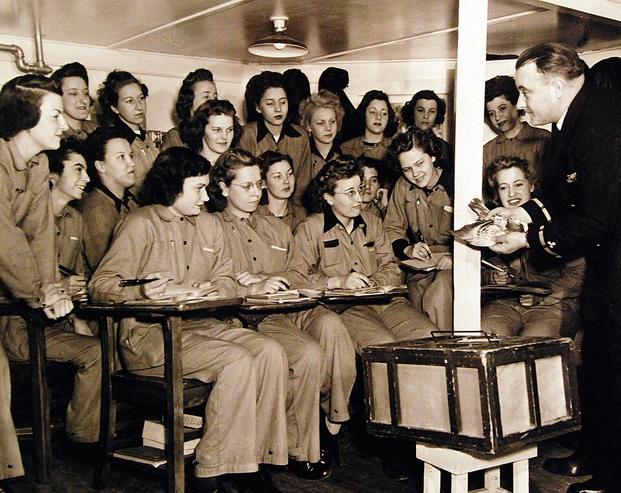The U.S. Navy's use of pigeons began decades before World War II, but the birds found their most critical mission during the war—flying messages from submarine-hunting blimps during a time when radio silence was essential.
Pigeons in U.S. Navy Service
According to the Naval History and Heritage Command, the Naval Academy at Annapolis established the Navy's first pigeon breeding and training program in 1891. The Navy officially established the U.S. Naval Pigeon Messenger Service in 1896, building pigeon lofts at major naval facilities along both coasts.
When the United States declared war on Spain in 1898, Navy messenger pigeons carried official communications from ships to shore along the Atlantic seaboard. But wireless telegraph technology soon made the birds obsolete. By 1902, all new Navy ships had some form of radio equipment, and the service auctioned off its pigeons.
The Navy brought pigeons back during World War I, developing the pigeon trainer enlisted rating. The Quartermaster (Pigeon) designation required sailors to complete six to 12 months of specialized training before receiving orders to air stations with pigeon facilities.
Following the war, pigeons were again briefly retired from the service as radio technology and better communication practices became more widespread.
By WWII, radio communications were no longer fully secure, and the Navy needed a new way to transmit messages without the enemy listening in.

Silent Communication for Navy Submarine Hunters
Naval Air Station Lakehurst in New Jersey served as the primary operating base for Navy airships in the Atlantic during WWII. Pigeons were routinely taken aboard airships conducting stateside antisubmarine patrols. Every airship carried six pigeons in crates.
The birds solved a tactical problem for the Navy. Navy K-class blimps excelled at hunting submarines because they could hover for hours over suspected contacts and observe for any movement. But radio transmissions from the airships would alert U-Boats who would then dive and escape before the destroyers arrived.
Instead of relying on radio transmissions, the Navy used the pigeons to carry messages in black plastic capsules attached to their legs for routine communications, and red capsules for emergencies. Upon receiving a message from an airship warning a submarine was in the area, Navy destroyers could close in for the kill.
During WWII, Navy blimps conducted 37,000 patrols and flew 378,237 hours, mainly off the Atlantic coasts of North and South America, over the Caribbean and later near the Strait of Gibraltar and the western Mediterranean. According to the U.S. Naval Institute, not one ship in a convoy escorted by blimps was lost to enemy submarine attack.
Pigeons played a vital role in ensuring any U-Boats were detected and intercepted before they could strike the convoys. In fact, the U-Boats would find themselves under attack by escorts before they even realized they had been compromised—completely oblivious that it was because of an animal as unexpected as a pigeon.

Women Join the Navy as Pigeoneers
To help facilitate the training and usage of pigeons during the war, the Navy established the Specialist (X) (PI) rating for pigeon trainers in 1942. In 1943, the rating opened to Women Accepted for Volunteer Emergency Service (WAVES).
One of the women who took up this military job was Pearl Nill Robbins who enlisted in September 1943 and began active duty the following month. She was among the first group of approximately 20 WAVES to complete the six-month training program at NAS Lakehurst, earning the rank of Specialist X (Pigeoneer).
“I knew I was a pioneer, first for just being able to join the military service, and second as one of the first females to serve as a pigeoneer,” Robbins told the Waco Tribune-Herald in 2018. “Just like women who join today, I wanted to serve my country.”
Requirements were identical for men and women—experience with birds or animals, plus the ability to drive a car to retrieve lost pigeons during training.
The WAVES pigeoneers trained the birds at the base, but did not serve on the blimps themselves. Their job was solely to breed, handle, train and care for the pigeons in the lofts at NAS Lakehurst. Once the birds were trained and ready for service, male airship crews took them on antisubmarine patrols while the women remained at the station maintaining the pigeon program.

Better Navy Birds Through Breeding
Following the successful use of pigeons as messengers during WWI, the Army's Signal Corps created the main breeding programs at Fort Monmouth, New Jersey, and other facilities, which developed faster, stronger birds with better homing instincts. According to America in WWII magazine, the goal was to produce superior messenger pigeons.
That selective breeding program paid off. While WWI pigeons could fly about 200 miles in one flight, WWII birds could easily double that distance, with some traveling 600 miles. Over short distances, the birds could approach 60 miles per hour, though 35 to 40 miles per hour was typical cruising speed.
According to the National Museum of American History, more than 95 percent of messages carried by homing pigeons were successfully delivered during WWII. Although slower than radio transmissions, the birds were the next best way to quickly transmit secure messages between airships and submarine hunters.

End of a Naval Era
The pigeon trainer rating surprisingly survived long after the war ended. According to Naval History and Heritage Command, the Specialist X pigeon trainer rating was phased out after WWII when the Navy returned to a peacetime structure.
On Jan. 1, 1948, pigeon trainers were transferred to an emergency service rating category so they could be retained and slowly retired from service. All of the exclusive emergency service ratings were eliminated in January 1961, finally bringing the Navy’s usage of pigeons to an official end.
By then, reliable and better secured radio communications had rendered the birds completely obsolete as the last pigeon trainers left the service. But for the decades leading up to, during and even after WWII, Navy pigeons provided a vital backup communication system when high-tech solutions failed or would compromise military operations.















